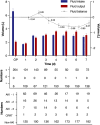Relevance of perioperative fluid dynamics in liver transplantation to acute kidney injury and patient outcomes: a cross-sectional survey
- PMID: 39776465
- PMCID: PMC11703520
- DOI: 10.1080/20523211.2024.2438225
Relevance of perioperative fluid dynamics in liver transplantation to acute kidney injury and patient outcomes: a cross-sectional survey
Abstract
Background: Fluid administration is a critical component of perioperative management for liver transplant recipients, and excessive fluid infusion can lead to acute kidney injury (AKI) and poor patient outcomes.
Method: We conducted a cross-sectional survey on the fluid intake and output of adult liver transplant recipients over a 7-day period. The patients were divided into AKI and non-AKI groups. Multivariate logistic regression analyses were used to evaluate the association between fluid balance (FB) and AKI. A Kaplan-Meier survival analysis was performed to determine the survival of the recipient survival at 180 days.
Results: A total of 210 liver transplant recipients were included. The peak FB occurred on the second day after transplantation, which was higher than on the seventh day (0.3 [IQR, -0.2 to 0.8] L vs. -0.4 [IQR, -1.0 to 0.3] L, p < 0.001). The highest incidence of AKI was observed on the second day after transplantation and the lowest on the seventh day (52.4% vs. 15.4%, p < 0.001). Multivariate analysis showed that a cumulative FB > 1 L within the first 2 days postoperatively was an independent risk factor for AKI on the second day after liver transplantation (LT) (OR = 2.66, 95% CI, 1.31-5.41, p = 0.007). Survival analysis indicated significant differences in 180-day survival rates among patients with different grades of AKI [94.0% (grade 1) vs. 91.4% (grade 2) vs. 77.8% (grade 3), χ 2 = 12.93, p < 0.001].
Conclusion: There is a significant correlation between post-LT AKI and perioperative FB. Cumulative FB > 1 L in the first 2 days postoperatively is an independent risk factor for AKI on the second day after LT. AKI after LT is associated with a lower 180-day survival rate in patients.
Keywords: Liver transplantation; acute kidney injury; cumulative fluid balance; fluid management; perioperative.
© 2024 The Author(s). Published by Informa UK Limited, trading as Taylor & Francis Group.
Conflict of interest statement
No potential conflict of interest was reported by the author(s).
Figures
Similar articles
-
Effect of cumulative fluid balance on acute kidney injury and patient outcomes after orthotopic liver transplantation: A retrospective cohort study.Nephrology (Carlton). 2020 Sep;25(9):700-707. doi: 10.1111/nep.13702. Epub 2020 Mar 12. Nephrology (Carlton). 2020. PMID: 32105370
-
Cumulative positive fluid balance is a risk factor for acute kidney injury and requirement for renal replacement therapy after liver transplantation.World J Transplant. 2018 Apr 24;8(2):44-51. doi: 10.5500/wjt.v8.i2.44. World J Transplant. 2018. PMID: 29696105 Free PMC article.
-
How a positive fluid balance develops in acute kidney injury: A binational, observational study.J Crit Care. 2024 Aug;82:154809. doi: 10.1016/j.jcrc.2024.154809. Epub 2024 Apr 11. J Crit Care. 2024. PMID: 38609773
-
AGA Clinical Practice Update on the Evaluation and Management of Acute Kidney Injury in Patients With Cirrhosis: Expert Review.Clin Gastroenterol Hepatol. 2022 Dec;20(12):2707-2716. doi: 10.1016/j.cgh.2022.08.033. Epub 2022 Sep 6. Clin Gastroenterol Hepatol. 2022. PMID: 36075500 Review.
-
Acute kidney injury and post-reperfusion syndrome in liver transplantation.World J Gastroenterol. 2016 Nov 14;22(42):9314-9323. doi: 10.3748/wjg.v22.i42.9314. World J Gastroenterol. 2016. PMID: 27895419 Free PMC article. Review.
Cited by
-
Development and validation of a nomogram for predicting the occurrence of acute kidney injury in patients with pulmonary embolism.Ren Fail. 2025 Dec;47(1):2510003. doi: 10.1080/0886022X.2025.2510003. Epub 2025 Jun 3. Ren Fail. 2025. PMID: 40462517 Free PMC article.
References
-
- Bezinover, D., Mukhtar, A., Wagener, G., Wray, C., Blasi, A., Kronish, K., Zerillo, J., Tomescu, D., Pustavoitau, A., Gitman, M., Singh, A., & Saner, F. H. (2021). Hemodynamic instability during liver transplantation in patients with end-stage liver disease: A consensus document from ILTS, LICAGE, and SATA. Transplantation, 105(10), 2184–2200. 10.1097/TP.0000000000003642 - DOI - PubMed
-
- Brustia, R., Monsel, A., Skurzak, S., Schiffer, E., Carrier, F. M., Patrono, D., Kaba, A., Detry, O., Malbouisson, L., Andraus, W., Vandenbroucke-Menu, F., Biancofiore, G., Kaido, T., Compagnon, P., Uemoto, S., Rodriguez Laiz, G., De Boer, M., Orloff, S., Melgar, P., … Scatton, O. (2022). Guidelines for perioperative care for liver transplantation: Enhanced recovery after surgery (ERAS) Recommendations. Transplantation, 106(3), 552–561. 10.1097/TP.0000000000003808 - DOI - PubMed
-
- Carrier, F. M., Chassé, M., Sylvestre, M. P., Girard, M., Legendre-Courville, L., Massicotte, L., & Bilodeau, M. (2020). Effects of intraoperative fluid balance during liver transplantation on postoperative acute kidney injury: An observational cohort study. Transplantation, 104(7), 1419–1428. 10.1097/TP.0000000000002998 - DOI - PubMed
-
- Chen, C., Guan, Q., Li, D., Sheng, B., Zhang, Z., & Hu, Y. (2024). Clinical characteristics and risk factor analysis of recipients with multidrug-resistant bacterial bloodstream infections after liver transplantation: A single-centre retrospective study. Journal of Pharmaceutical Policy and Practice, 17(1), 2390072. 10.1080/20523211.2024.2390072 - DOI - PMC - PubMed
LinkOut - more resources
Full Text Sources


